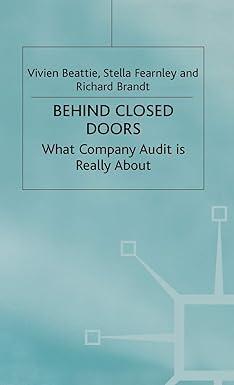Question
1. Which of the following is NOT an advantage of using standard costs and variances? A. Use as a performance benchmark for evaluation of actual
1. Which of the following is NOT an advantage of using standard costs and variances?
A. Use as a performance benchmark for evaluation of actual costs
B. Use as a basis for components of the master budget
C. Simplification of bookkeeping
D. Change in behavior of managers to obtain desired variances
2. One level of a companys flexible budget was prepared for production of 8,000 units. Total costs were $38,000 and included direct materials, direct labor, and variable overhead at $1.50, $2.50, and $0.50 per unit respectively. What is the total cost of production of 8,500 units?
A. $ 2,000
B. $38,000
C. $38,250
D. $40,250
3. The direct labor price variance was unfavorable and much greater than anticipated. Who would be in the best position to explain why the unfavorable variance occurred?
A. Both the production and human resource supervisors
B. The production supervisor
C. The purchasing manager
D. Both the purchasing manager and production supervisor
4. A manager purchased better quality materials for a slightly higher cost than anticipated. However, as a result, there was less spoilage than normal. What is the effect on the price and quantity variances respectively?
A. Favorable, favorable
B. Favorable, unfavorable
C. Unfavorable, favorable
D. Unfavorable, unfavorable
5. A company uses a single raw material in its production process. The standard price for a unit of material is $2.00. During the month the company purchased and used 600 units of this material at a price of $2.25 per unit. The standard quantity required per finished product is 2 units and during the month, the company produced 310 finished units. How much was the material price variance?
A. $150 favorable
B. $150 unfavorable
C. $155 favorable
D. $155 unfavorable
6. A company uses a single raw material in its production process. The standard price for a unit of material is $2.00. During the month the company purchased and used 600 units of this material at a price of $2.25 per unit. The standard quantity required per finished product is 2 units and during the month, the company produced 310 finished units. How much was the material quantity variance?
A. $40 favorable
B. $40 unfavorable
C. $45 favorable
D. $45 unfavorable
7. A company produced 2,200 units of output during a production process that normally requires 2 hours of labor per unit of output. The standard labor rate is $16 per hour, but the company paid $15 per hour. Actual hours needed to complete the production process were 4,600. How much was the labor efficiency variance?
A. $3,000 favorable
B. $3,000 unfavorable
C. $3,200 favorable
D. $3,200 unfavorable
8. A company produced 2,200 units of output during a production process that normally requires 2 hours of labor per unit of output. The standard labor rate is $16 per hour, but the company paid $15 per hour. Actual hours needed to complete the production process were 4,600. How much was the labor rate variance?
A. $4,400 favorable
B. $4,400 unfavorable
C. $4,600 favorable
D. $4,600 unfavorable
9. Which of the following formulas is used to compute variable overhead rate (or spending) variance?
A. actual hours (actual rate ? standard rate)
B. standard hours allowed (actual rate ? standard rate)
C. actual rate (actual hours ? standard hours allowed)
D. standard rate (actual hours ? standard hours allowed)
10. Which of the following is a true statement regarding fixed overhead volume variance?
A. If production volume is less than anticipated, then fixed overhead has been underallocated and the fixed overhead volume variance is favorable.
B. If production volume is less than anticipated, then fixed overhead has been underallocated and the fixed overhead volume variance is unfavorable.
C. If production volume is greater than anticipated, then fixed overhead has been underallocated and the fixed overhead volume variance is favorable.
D. If production volume is greater than anticipated, then fixed overhead has been overallocated and the fixed overhead volume variance is unfavorable.
Step by Step Solution
There are 3 Steps involved in it
Step: 1

Get Instant Access to Expert-Tailored Solutions
See step-by-step solutions with expert insights and AI powered tools for academic success
Step: 2

Step: 3

Ace Your Homework with AI
Get the answers you need in no time with our AI-driven, step-by-step assistance
Get Started


